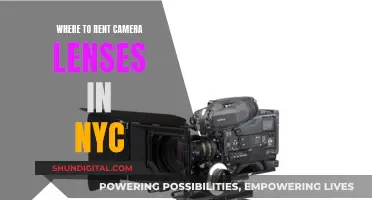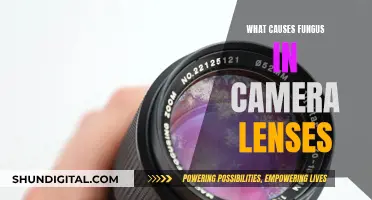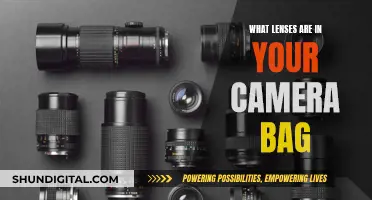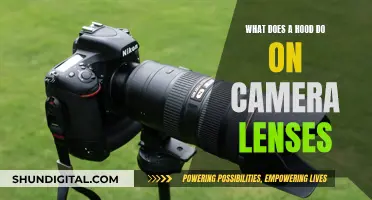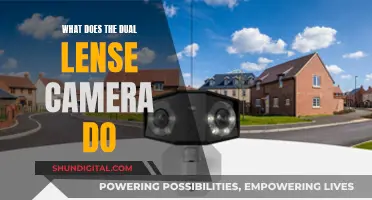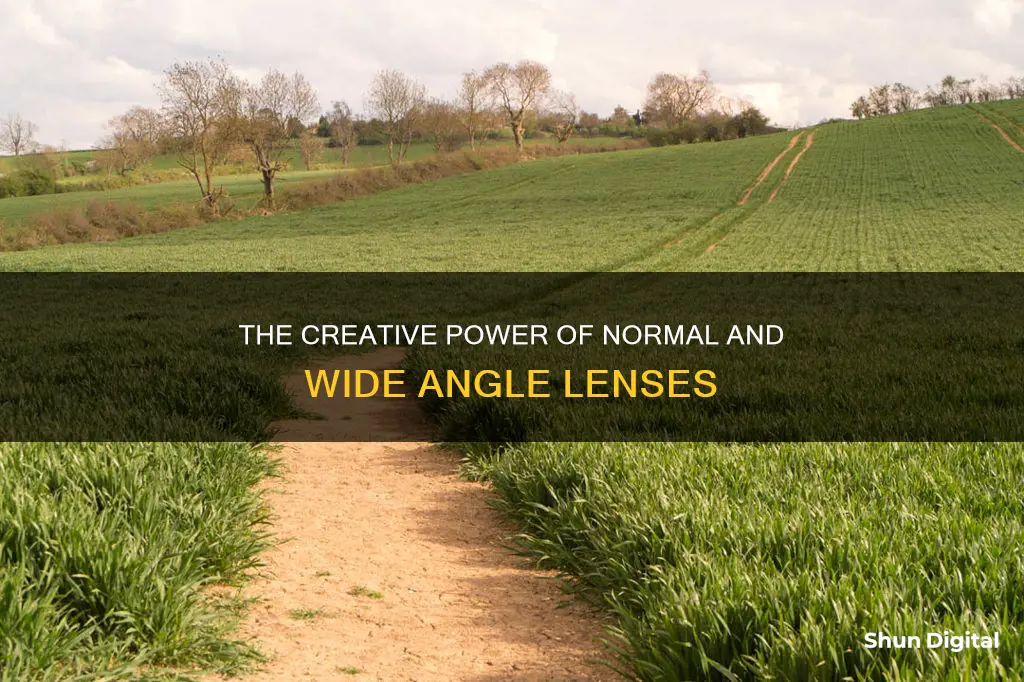
A wide-angle lens is any lens with a focal length shorter than the length of the sensor or film. For full-frame sensors, a wide-angle lens would be any lens with a focal length equal to or less than 35mm. A standard wide-angle lens has a focal length between 24mm and 35mm, while anything between 24mm and 18mm is considered an ultra-wide-angle lens.
Wide-angle lenses are used to capture more of a scene in a photograph and are particularly useful for architectural, interior, and landscape photography. They can also be used to emphasise the difference in size or distance between objects in the foreground and background, making nearby objects appear larger and those at a moderate distance smaller and farther away.
Normal lenses, on the other hand, have a focal length approximately equal to the length of the diagonal of the image frame or digital photosensor. In cinematography, a lens of roughly twice the diagonal is considered normal.
| Characteristics | Values |
|---|---|
| Focal length | 35mm or shorter |
| Field of view | Wide |
| Use | Landscape, architecture, real estate, travel, street, event, and night sky photography |
| Subtypes | Ultrawide-angle, standard wide-angle, fisheye |
| Ultrawide-angle focal length | Under 16mm |
| Fisheye field of view | 180-degrees |
| Standard wide-angle focal length | 24mm to 35mm |
| Ultrawide-angle zoom range | 12mm-24mm |
| Standard wide-angle zoom range | 16mm-35mm |
| Distortion | Barrel |
| Cropped sensor conversion | Reduces field of view |
What You'll Learn

Wide-angle lenses are great for street photography
Wide-angle lenses are also useful for street photography because they allow more of the scene to be included in the photograph. This is especially useful in street photography, where the photographer may not be able to move farther from the scene to capture it.
The background in a street photograph gives viewers a visual cue as to what is going on. Removing the subject from its context may be aesthetically pleasing, but it detracts from the visual meaning behind the photograph. Wide-angle lenses show much more context than telephoto lenses, which tend to flatten the background and isolate the subject.
Wide-angle lenses are also great for street photography because they are lightweight and easy to carry around. They are also less noticeable, so you will be able to get closer to your subjects without them realising.
A 35mm lens is probably the most common lens used by street photographers because it has a lot of advantages in this fast-moving genre. It is wide enough to capture multiple subjects in the frame or a subject and a background. This is great for those who like to capture juxtapositions or many people or elements in their photos.
A 50mm lens allows you to get a little further back. You can focus more on your main subject, their features, and their expressions without worrying about as many distracting details. This is great for those who are nervous about street photography because you don't have to get as close.
Full-Frame Lenses: Sharper on Crop Sensor Cameras?
You may want to see also

They are useful for travel photography
Wide-angle lenses are a great choice for travel photography as they are versatile and lightweight. They are particularly useful for capturing landscapes, cityscapes, architecture, and street photography. Their wide field of view allows you to capture more of the scene in front of you, making them ideal for travel situations where you want to capture as much detail as possible.
When travelling, it is often more convenient to pack light and carry fewer lenses. A wide-angle lens can be a good choice in this situation as it covers a large angle of view and can be used for various types of shots. This means you can capture a wide variety of scenes without having to constantly switch lenses.
Wide-angle lenses are also useful for emphasising the difference in size or distance between objects in the foreground and background. Nearby objects will appear larger, while objects at a moderate distance will seem smaller and farther away. This can create a sense of depth and make your photos more dynamic.
Another benefit of wide-angle lenses for travel photography is their ability to capture the context and atmosphere of a location. They can include more of the background and surroundings, providing a sense of place and giving your photos a sense of environmental portraiture. This is especially useful when photographing people in their natural environments or capturing the unique details of a new place.
However, one challenge of using wide-angle lenses for travel photography is that they often include more of the background than you may want. This can result in cluttered or messy backgrounds, as you have no control over what other people or elements are in the scene. It can be tricky to achieve clean and simple compositions with wide-angle lenses, and you may need to be more selective about your framing and the lens aperture to achieve the desired effect.
Overall, wide-angle lenses are a valuable tool for travel photography, allowing you to capture expansive scenes, emphasise depth, and provide context to your images. They are a versatile choice that can help you capture the beauty and uniqueness of the places you visit.
Cleaning Camera Lenses: Removing Scratches, Restoring Clarity
You may want to see also

They can be used for architecture and real estate photography
Normal and wide-angle lenses are used extensively in architecture and real estate photography. A wide-angle lens is any lens with a set focal length that is shorter than the length of the sensor or film. For full-frame sensors, a wide-angle lens would be any lens with a focal length equal to or less than 35mm. Wide-angle lenses are used to capture expansive settings like buildings, empty deserts, concrete jungles, or eerie hotels. They are also used to capture the blocking and staging of a scene, allowing the audience to see the whole movements of the actors, revealing their body language and actions.
In architecture and real estate photography, wide-angle lenses are used to capture interior shots of buildings. They are also used to capture tall buildings without having to adjust the camera position. For example, a photographer may want to capture the interior of a historic church but can only back up so far into the nave before they are no longer indoors. In this case, a wide-angle lens would be the only way to get everything they want into the frame.
Wide-angle lenses are also useful for real estate photography, as they can capture wide-angle interior shots and focus on any detail shots that may be needed. They are also handy on unpredictable site visits when the photographer may need to zoom out for an overall construction shot or zoom in on an intricate wall section detail.
Ultra-wide lenses are recommended for interior shots, and tilt-shift lenses are often used to capture tall buildings without the need to adjust the camera position.
Understanding Camera Lenses: Decoding the Specs
You may want to see also

They are ideal for landscape photography
Wide-angle lenses are ideal for landscape photography for several reasons.
Firstly, they have a shorter focal length than normal lenses, allowing for a wider field of view and enabling photographers to capture more of the scene in the photograph. This is particularly useful for landscape photography, as it allows photographers to capture expansive vistas and starry nights. With wide-angle lenses, photographers can also emphasise the difference in size or distance between objects in the foreground and background, making foreground objects more prominent and striking while capturing expansive backgrounds.
Secondly, wide-angle lenses are well-suited for travel photography due to their short focal length, providing more versatility to capture a multitude of scenes. They are also useful for street photography, as they can provide a dramatic perspective and a sense of presence.
Thirdly, wide-angle lenses are often used in landscape photography to create a sense of inclusion, making the viewer feel more a part of the scene than when using longer telephoto lenses.
Finally, wide-angle lenses can be used to create interesting and unique images by distorting things and enhancing perspective. Objects closer to the camera appear larger than those farther away, even if they are the same size in reality. This can be used to create a sense of depth and make the image more engaging.
However, it is important to note that wide-angle lenses can also distort images, especially when photographing people, so photographers should be mindful of this when composing their shots.
Camera Lenses: Understanding the Basics of Photography
You may want to see also

Wide-angle lenses are good for event photography and photojournalism
Wide-angle lenses are a great tool for event photography and photojournalism. They can help you capture more of a scene and create a sense of inclusion in your images. Here's why wide-angle lenses are good for these types of photography:
- Capturing the Bigger Picture: Wide-angle lenses have a shorter focal length than normal lenses, allowing you to capture a larger field of view. This is beneficial when you need to capture expansive settings or include more of the scene in your frame. For event photography, this can be useful when photographing large venues, capturing the atmosphere of a crowded room, or getting everyone in a group photo.
- Immersive Perspective: Wide-angle lenses can create a sense of immersion by distorting perspective and enhancing the relative size of objects. Nearby objects appear larger, while those at a moderate distance seem smaller and farther away. This can be used creatively in event photography to emphasise the size of a venue, make a subject stand out, or convey a sense of depth and inclusion.
- Dynamic Camera Movement: Wide-angle lenses amplify camera movement, making them ideal for capturing dynamic scenes at events. Whether it's a fast dolly shot or a slow push-in, wide-angle lenses can add a sense of motion and energy to your photographs.
- Versatility: Wide-angle lenses offer versatility in event photography. They allow you to capture a wide range of scenes, from large group photos to close-up details, without having to switch lenses constantly. This versatility is especially useful when you need to adapt quickly to changing environments or capture fleeting moments.
- Low-Light Performance: Wide-angle lenses often have larger maximum apertures, making them well-suited for low-light event photography. Their ability to capture more light means you can use faster shutter speeds and still achieve proper exposure, which is crucial for capturing fast-paced action or subjects in motion.
- Subject and Background Separation: With their wide apertures, wide-angle lenses can create a shallow depth of field, allowing you to separate your subject from the background. This technique is valuable in event photography when you want to highlight a specific person or object while blurring the busy background.
- Creative Flexibility: Wide-angle lenses offer creative flexibility in event photography. They enable you to play with perspective, experiment with different compositions, and capture unique angles that draw viewers into your images.
When used skillfully, wide-angle lenses can elevate your event photography and photojournalism, helping you capture captivating images that tell a story and engage your audience.
Camera Lenses: Heavy Weights for the Perfect Shot
You may want to see also



